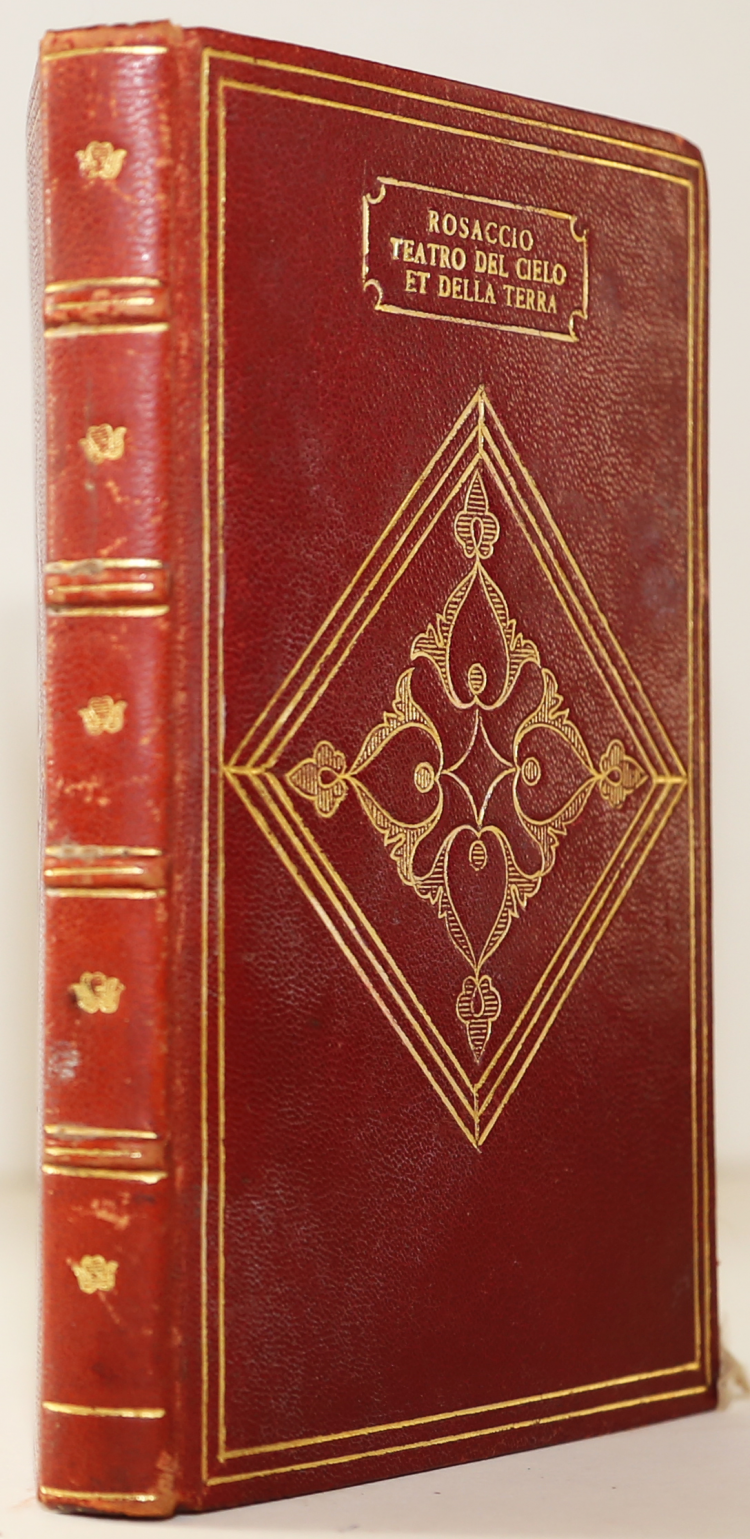











| Reference: | S0079 |
| Author | Giuseppe ROSACCIO |
| Year: | 1629 |
| Zone: | - |
| Measures: | 100 x 155 mm |










| Reference: | S0079 |
| Author | Giuseppe ROSACCIO |
| Year: | 1629 |
| Zone: | - |
| Measures: | 100 x 155 mm |
In-8° small (14.5x10 cm), Binding in red morocco, spine with four nerves and gilt floral decoration at sections, double gold threading on the plates and a floral lozenge motif in the center. Title in gold on the front plate; threaded squares and gilt edges. pp.141, (1), (2) white, (8), double title page, the second with a globe, 3 figures in the text, 11 maps (including 8 double-page), 4 animated letterheads, woodcut. Marking: [A-I8, *8].
Fascinating edition of one of the most successful texts by Giuseppe Rosaccio (Pordenone, 1530-Venice, 1621 ca.).He was a Venetian physician and cosmographer. He was an authority on the Geography of Claudius Ptolemy, of which he published the Italian version of Ruscelli, with additions by himself in 1598-1599 Also important was his Discorso... della Nobilita e Eccellenza della Terra rispetto à Cieli (Florence c 1610-1615), a speculative world geography which summarized recent published accounts of Pacific voyages.
In 1580 he published for the first time Il Teatro del Cielo e della Terra, set according to the Aristotelian-Thelemic conception, in which he illustrates the spherical structure of the cosmos through this hierarchy: Empyrean Sky, First mobile, Crystalline Sky, Saturn, Jupiter, Mars, Sun, Venus, Mercury, Moon, Fire, Air, Water, Earth, Abram's Breast, Limbo, Purgatory, Hell. This work if on the one hand is presented as a classic humanistic encyclopedia unifying, then, according to the worldview of the late sixteenth century, very various topics ranging from astronomy, philosophy of nature, geology to religion, on the other hand, however, provides precise information both textual and graphic aspects of geography and topography based on studies but also on field research (mainly on 'Italy and Europe): as an example news on various aspects of the Appennino tosco-emiliano (Porretta, San Donino); Sicily and Sardinia; Scandinavian countries; Islands of the seas of the North (Orcadi, Hebrides, Shetland); etc. There are also climatic news and on the comets. All drawings are by the author of Dedication of the printer to the Venetian nobleman Andrea Bragadino
Reference:
Liruti, Letterati del Friuli, IV, pp. 166-169.
Giuseppe ROSACCIO Pordenone circa 1530 – Venezia 1621
|
physician, travel writer, geographer, cosmographer and cartographer, he is known for some geographical and cosmographical works, which, although not large volume, brought him some fame and was reprinted several times. Among them the Teatro del Cielo e della Terra (Venezia 1595), Mondo e le sue parti, cioè Europa, Affrica, Asia et America (Verona 1596), il Microcosmo (Firenze 1600), iMondo elementare e celeste (Treviso 1604), il Discorso sulla nobiltà ed eccellenza della Terra (Firenze). He also supervised an edition of Ptolemy's Geography, printed in Venice in 1599, accompanied with some Discorsi and 42 new tables. He is also the author of a large map of the world (Venice 1597), a large map of Italy (Florence 1609) and one of Tuscany (Florence 1609). In all these works, however, shows little originality. (Almagià)
|
Giuseppe ROSACCIO Pordenone circa 1530 – Venezia 1621
|
physician, travel writer, geographer, cosmographer and cartographer, he is known for some geographical and cosmographical works, which, although not large volume, brought him some fame and was reprinted several times. Among them the Teatro del Cielo e della Terra (Venezia 1595), Mondo e le sue parti, cioè Europa, Affrica, Asia et America (Verona 1596), il Microcosmo (Firenze 1600), iMondo elementare e celeste (Treviso 1604), il Discorso sulla nobiltà ed eccellenza della Terra (Firenze). He also supervised an edition of Ptolemy's Geography, printed in Venice in 1599, accompanied with some Discorsi and 42 new tables. He is also the author of a large map of the world (Venice 1597), a large map of Italy (Florence 1609) and one of Tuscany (Florence 1609). In all these works, however, shows little originality. (Almagià)
|